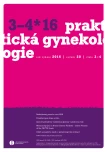Cardiovascular changes in pregnancy II.
Preeclampsia and its long-term consequences for mother and offspring
Authors:
Liana Greiffeneggová 1,2; Drahoslava Hrubá 2
Authors‘ workplace:
Katedra porodní asistence a zdravotnických záchranářů, LF MU, Brno
1; Ústav ochrany a podpory zdraví, LF MU, Brno
2
Published in:
Prakt Gyn 2016; 20(3-4): 143-146
Category:
Gynecology and Obstetrics
Overview
The most often complication is preeclampsia which affects 3 % to 5 % of pregnancies and is a leading cause of maternal mortality, expecially in developing countries. Epidemiological studies have repeatedly described, that preeclampsia contributes to future cardiovascular disease. The investigation of possible mechanisms of preeclampsia may lead to new insights into the pathogenesis of cardiovascular disease in women and open the new practical goals for prevention
Key words:
cardiovascular diseases – elevated risk – epidemiologic evidence – preeclampsia – prevention – pregnancy – possible pathways
Sources
1. Thadhani R, Ecker JL, Kettyle F et al. Pulse pressure and risk of preeclampsia: s prospective study. Obstet Gynecol 2001; 97(4): 515–520.
2. Stillman IE, Karumanchi SA. The glomerular injury of preeclampsa. J Am Soc Nephol 2007; 18(8): 2281–2284.
3. von Dadaelszen P, Magee LA, Roberts JM. Subclassification of preeclampsia. Hypertension in Pregnancy 2003; 22(2): 143–148.
4. Powe CE, Levine RJ, Karumanchi SA. Preeclampsia: a disease of the maternal endothelium. The role of antiangiogenic factors and implications for later cardiovascular disease. Circulation 2011; 123(24): 2856–2869. Dostupné z DOI: <http://dx.doi.org/10.1161/CIRCULATIONAHA.109.853127>.
5. Wang JX, Knottnerus AM, Schuit G et al. Surgically obtained sperm, and risk of gestational hypertenson and pre-eclampsia. Lancet 2002; 359(9307): 673–674.
6. Conde-Agudelo A, Althabe F, Belizan JM et al. Cigarette smoking during pregnancy and risk of preeclampsia: a systematic review. Am J Obstet Gynecol 1999; 181(4): 1026–1035.
7. Karumanchi SA, Levine RJ. How does smoking reduce the risk of preeclampsia? Hypertension 2010; 55(5): 1100–1101. Dostupné z DOI: <http://dx.doi.org/10.1161/HYPERTENSIONAHA.109.148973>.
8. Zhou Y, Damsky CH, Fisher SJ. Preeclampsia is associate with failure of human cytotrophoblast to mimic a vascular adhesion phenotype: ona cause of defective endovascular invasion in this syndrome? J Clin Invest 1997; 99(9): 2152–2164.
9. Sandrim VC, Palei AC, Metzger IF et al. Nitric oxide formationis inversaly related to serum levels of antiangiogenic factors solublefms-liketarosine kinase-1 and soluble andogline in preeclampsia. Hypertension 2008; 52(2): 402–407. Dostupné z DOI: <http://dx.doi.org/10.1161/HYPERTENSIONAHA.108.115006>.
10. Bálková O. Novinky v laboratorní diagnostice a predikci preeklampsie. Prakt Gyn 2014; 18(2): 127–129.
11. Powers RW, Roberts JM, Cooper KM et al. Maternal serum soluble fms-like tyrosine kinase 1 concentrations are not increased in early pregnancy and decrease more slowly postpartum in women who develop preeclampsia. Am J Obstet Gynecol 2005; 193(1): 185–191.
12. Germain AM, Romanik MC, Guerra I et al. Endothelial dysfunction: A link among preeclampsia, recurrent pregnancy loss, and future cardiovascular events? Hypertension 2007; 49(1): 90–95.
13. Jayet PY, Rimoldi SF, Stuber T et al. Pulmonary and systemic vascular dysfunction in young offspring of mothers with preeclampsia. Circulation 2010; 122(5): 488–494. Dostupné z DOI: <http://dx.doi.org/10.1161/CIRCULATIONAHA>.
14. Vatten LJ, Romundstad PR, Holmen TL et al. Intreuterine exposure to preeclampsia and adolescent blood pressure, body size and age at menarche in female offsprings. Obstet Gynecol 2003; 101(3): 529–533.
15. Kajantie E, Eriksson JG, Osmond C et al. Preeclampsia is associated with increased risk of stroke in the adult offspring: the Helsinki birth cohort study. Stroke 2009; 40(4): 1176–1180. Dostupné z DOI: <http://dx.doi.org/10.1161/STROKEAHA.108.538025>.
16. Ray JG, VermeulenMJ, SchullMJ et al. Cardiovascular health after maternal placental syndromes (CHAMPS): population-based retrospective cohort study. Lancet 2005; 366(9499): 1797–1803.
17. Lykke JA, Langhoff-Roos J, Sibai BM et al. Hypertensive pregnancy disorders and subsequent cardiovascular morbidity and type 2 diabetes mellitus in the mother. Hypertension 2009; 53(6): 944–951. Dostupné z DOI: <http://dx.doi.org/10.1161/HYPERTENSIONAHA.109.130765>.
18. Pell JP, Smoth GC, Walsh D. Pregnancy complications and subsequent maternal cerebrovascular events: a retrospective cohort study of 119.668 births. Am J Epidemiol 2004; 159(4): 336–342.
19. Funai EF, Friedlander Y, Paltiel O et al. Long-term mortality after preeclampsia. Epidemiology 2005; 16(2): 206–215.
20. Mongraw-Chaffin ML, Cirillo PM, Cohn BA. Preeclampsia and cardiovascular disease death: prospective evidence from the Child Health and Development Studies Cohort. Hypertension 2010; 56(1): 166–171. Dostupné z DOI: <http://dx.doi.org/10.1161/HYPERTENSIONAHA.110.150078>.
21. McDonald SD, Malinowski A, Zhou Q et al. Cardiovascular sequelae of preeclampsia/eclampsia: A systematic review and meta analyses. Am Heart J 2008; 156(5): 918–930. Dostupné z DOI: <http://dx.doi.org/10.1016/j.ahj.2008.06.042>.
22. Bellamy L, Casas J-P, Hingorani AD et al. Pre-eclampsia and risk of cardiovascular disease and cancer in later life: systematic review and meta analysis. BMJ 2007; 335(7627): 974. Dostupné z DOI: <http://dx.doi.org/10.1136/bmj.39335.385301.BE>.
23. Agatisa PK, Ness RB, Roberts JM et al. Impairment of endothelial function in women with a history of preeclampsia: an indicator of cardiovascular risk. Am J Physiol Heart Circ Physiol 2004; 286(4): H1389-H1393.
24. 24.Vikse BE, Irgens LM, Leivestad T et al. Preeclampsia and the risk of end-stage renal disease. N Engl J Med 2008; 359(8):800–809. Dostupné z DOI: <http://dx.doi.org/10.1056/NEJMoa0706790>.
25. Duley L. The global impact of pre-eclampsia and eclampsia. Semin Perinatol 2009; 33(3): 130–137. Dostupné z DOI: <http://dx.doi.org/10.1053/j.semperi.2009.02.010>.
26. Hunt P. Maternal health and human rights. Lancet 2008; 371(9608): 203. Dostupné z DOI: <http://dx.doi.org/10.1016/S0140–6736(08)60129–4>.
Labels
Paediatric gynaecology Gynaecology and obstetrics Reproduction medicineArticle was published in
Practical Gynecology

2016 Issue 3-4
Most read in this issue
- Physiotherapy after gynecologic abdominal surgery
- Conservative therapy of interstitial pregnancy with the use of methotrexate – case study
- Preeclampsia today and tomorrow
- Pain-free childbirth in 2016
